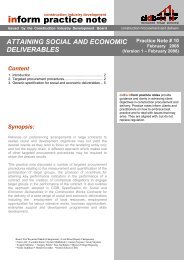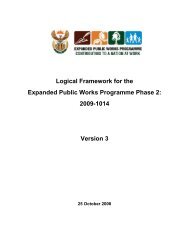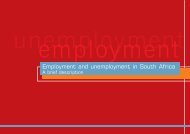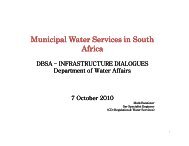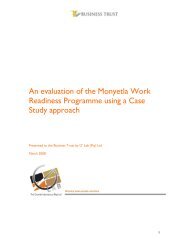National Infrastructure Maintenance Strategy - Construction Industry ...
National Infrastructure Maintenance Strategy - Construction Industry ...
National Infrastructure Maintenance Strategy - Construction Industry ...
You also want an ePaper? Increase the reach of your titles
YUMPU automatically turns print PDFs into web optimized ePapers that Google loves.
Summary<br />
The main cause of inadequate maintenance of<br />
national government buildings has been<br />
inadequate budgeting for maintenance. Increasing<br />
the user charges will enable maintenance budgets<br />
to increase, resulting in improvement to the<br />
condition of the buildings.<br />
d. Municipalities<br />
Overview of municipal infrastructure and<br />
service delivery<br />
Municipalities are typically responsible for water<br />
services (including sanitation), roads and<br />
stormwater, solid waste collection and disposal,<br />
and, in many but not all cases, the distribution of<br />
electricity. They are also responsible for an array of<br />
public facilities and amenities, including sports<br />
fields, community halls and libraries. They may<br />
also be responsible for low-income housing.<br />
The CSIR has estimated that the current<br />
replacement cost of all municipal engineering<br />
infrastructure and buildings (excluding housing) is<br />
at least R300 billion. Given the poor state of much<br />
of this, and the repair and refurbishment<br />
consequently required in addition to planned<br />
maintenance, international norms suggest that<br />
approximately 4% of the replacement value should<br />
on average be spent per annum on maintenance<br />
(excluding for disposal and replacement) -<br />
amounting to about R12 billion per annum.<br />
However, municipalities are on average budgeting<br />
for less than half of this.<br />
State of infrastructure and state of maintenance<br />
There are no formal broad-based audits of the<br />
state of municipal infrastructure. Particularly<br />
lacking is any overview of trends in the state and<br />
performance of local government infrastructure<br />
and its maintenance. However research<br />
undertaken by the cidb and CSIR reveals serious<br />
shortfalls (and in places gross shortfalls) in many<br />
municipalities' maintenance policies and practice.<br />
The sustained provision of services is in many<br />
cases under threat. Specifically, many<br />
municipalities are not conforming to the<br />
requirements of the MFMA, Municipal Systems Act<br />
and other legislation that they should ensure that<br />
adequate provision is made for the long-term<br />
maintenance of infrastructure assets.<br />
While many of the aspects of infrastructure<br />
maintenance are implemented to a high standard<br />
in a small number of municipalities, there are great<br />
shortfalls in maintenance policies and practice in<br />
many other municipalities. The sustained<br />
provision of services by a significant proportion of<br />
the municipal infrastructure is under threat.<br />
Generally, the municipalities in or close to the<br />
larger urban centres are coping better, while<br />
municipalities that are mostly rural in nature are<br />
struggling the most - but there are significant<br />
exceptions.<br />
Of concern at municipal level is the state of<br />
wastewater treatment, water treatment, water and<br />
sewer reticulation, on-site sanitation, electricity<br />
reticulation, and arterial roads -- these are the<br />
fundamental building blocks for economic growth<br />
and healthy communities. Of greatest concern is<br />
the state of wastewater treatment.<br />
The two principal causes of the ongoing failure of<br />
many municipalities to recover maintenance<br />
backlogs, run a preventative maintenance<br />
programme and deliver a reliable, sustainable<br />
service are:<br />
• inadequate revenue and budgets (either<br />
because these municipalities are in a distressed<br />
financial state and thus unable to fund<br />
infrastructure maintenance; or, even if they are<br />
not distressed, infrastructure maintenance is<br />
not prioritised in the planning and budgeting<br />
process); and<br />
• inadequate skills (especially technical skills)<br />
and experience to plan and implement<br />
appropriate maintenance programmes.<br />
Unpacking the first of these causes, the following<br />
are the greatest contributors to the inadequacy of<br />
revenue and budgets:<br />
• the increasing amount of infrastructure (new<br />
areas served, improved levels of service, and<br />
upgrading of existing service levels) owned by<br />
national infrastructure maintenance strategy<br />
22




